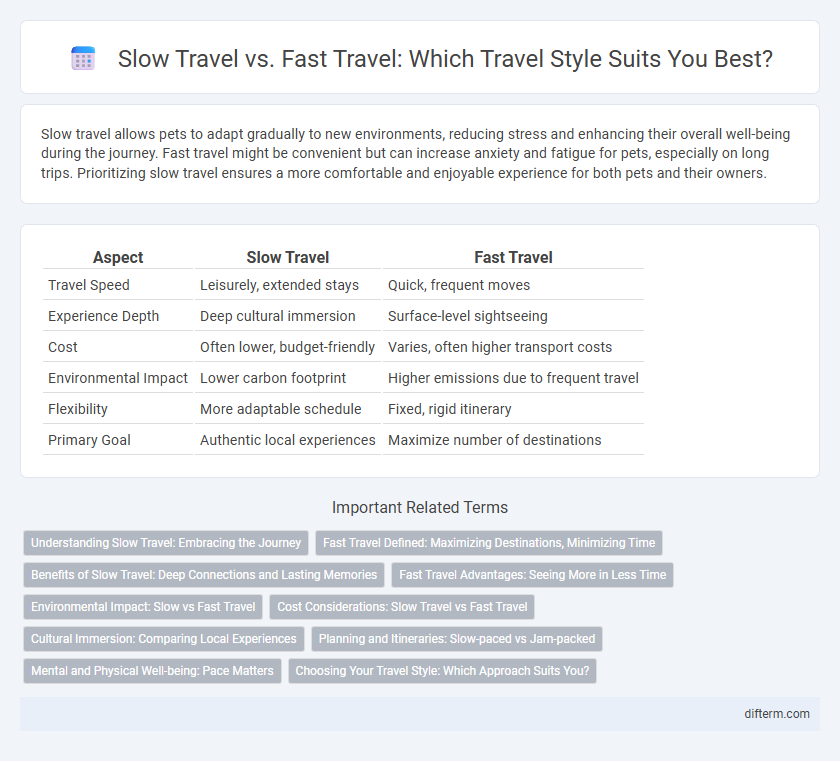Slow travel allows pets to adapt gradually to new environments, reducing stress and enhancing their overall well-being during the journey. Fast travel might be convenient but can increase anxiety and fatigue for pets, especially on long trips. Prioritizing slow travel ensures a more comfortable and enjoyable experience for both pets and their owners.
Table of Comparison
| Aspect | Slow Travel | Fast Travel |
|---|---|---|
| Travel Speed | Leisurely, extended stays | Quick, frequent moves |
| Experience Depth | Deep cultural immersion | Surface-level sightseeing |
| Cost | Often lower, budget-friendly | Varies, often higher transport costs |
| Environmental Impact | Lower carbon footprint | Higher emissions due to frequent travel |
| Flexibility | More adaptable schedule | Fixed, rigid itinerary |
| Primary Goal | Authentic local experiences | Maximize number of destinations |
Understanding Slow Travel: Embracing the Journey
Slow travel emphasizes immersing oneself in local culture, savoring authentic experiences, and building meaningful connections, contrasting with fast travel's rush to cover multiple destinations. This approach encourages travelers to prioritize quality over quantity, fostering deeper understanding and appreciation of the places visited. Embracing slow travel enhances mindfulness, reduces stress, and supports sustainable tourism practices by minimizing environmental impact.
Fast Travel Defined: Maximizing Destinations, Minimizing Time
Fast travel focuses on maximizing the number of destinations visited within a limited timeframe, emphasizing efficiency and extensive itinerary coverage. Travelers prioritize quick transfers, minimal dwell time, and often use high-speed transportation to cover large distances rapidly. This approach appeals to those seeking to experience diverse cultures and landmarks without prolonged stays in each location.
Benefits of Slow Travel: Deep Connections and Lasting Memories
Slow travel encourages immersive experiences by allowing travelers to engage deeply with local cultures, traditions, and communities, fostering authentic connections. Extended stays promote meaningful interactions with residents and the environment, resulting in richer stories and lasting memories. This approach enhances personal growth and a profound understanding of destination nuances often missed in fast travel.
Fast Travel Advantages: Seeing More in Less Time
Fast travel enables tourists to cover multiple destinations quickly, maximizing the number of attractions visited within limited time frames. Airlines, high-speed trains, and efficient transport networks support seamless movement across cities and countries, enhancing overall travel efficiency. This approach suits busy travelers seeking to experience diverse cultures, landmarks, and activities without extended stays.
Environmental Impact: Slow vs Fast Travel
Slow travel significantly reduces carbon emissions by prioritizing eco-friendly transportation methods such as trains, bicycles, and walking. Fast travel, often relying on airplanes and high-speed vehicles, contributes disproportionately to greenhouse gas emissions, accelerating climate change. Embracing slow travel supports sustainable tourism by minimizing environmental footprints and preserving natural ecosystems.
Cost Considerations: Slow Travel vs Fast Travel
Slow travel often reduces overall costs by emphasizing budget accommodations, local cuisine, and public transportation, allowing travelers to extend their stays without frequent expenses. Fast travel typically incurs higher costs due to multiple flights, connections, and short-term stays in pricier hotels, increasing transportation and lodging expenses. Choosing slow travel enables more efficient budget management, while fast travel demands a flexible, often higher spending capacity for rapid movement and convenience.
Cultural Immersion: Comparing Local Experiences
Slow travel fosters deeper cultural immersion by allowing travelers to engage meaningfully with local customs, traditions, and communities, often resulting in authentic experiences. Fast travel, while enabling visits to multiple destinations, frequently sacrifices time for true understanding, leading to more surface-level interactions. Prioritizing slow travel enhances the opportunity to participate in local festivals, cuisine, and daily life, enriching cultural appreciation beyond typical tourist activities.
Planning and Itineraries: Slow-paced vs Jam-packed
Slow travel emphasizes flexible planning with loosely structured itineraries, allowing immersive experiences and spontaneous discoveries at a relaxed pace. Fast travel requires tightly scheduled itineraries to maximize destinations covered within limited timeframes, often prioritizing iconic landmarks and quick transitions. Choosing between slow and fast travel influences the depth of cultural engagement and overall stress levels during the journey.
Mental and Physical Well-being: Pace Matters
Slow travel enhances mental and physical well-being by reducing stress and allowing deeper cultural immersion, promoting relaxation and mindfulness. Fast travel often causes fatigue and anxiety due to constant movement and limited rest, which can negatively impact overall health. Prioritizing a slower pace supports better sleep, lower cortisol levels, and more meaningful connections with surroundings.
Choosing Your Travel Style: Which Approach Suits You?
Slow travel emphasizes immersing yourself in local culture, spending more time in fewer destinations to experience authentic lifestyles and reduce environmental impact. Fast travel prioritizes seeing multiple locations quickly, ideal for those with limited time who want to maximize sightseeing and activities. Choose based on your personal preferences, available time, and desire for deep cultural connections versus broad exploration.
Slow travel vs Fast travel Infographic

 difterm.com
difterm.com